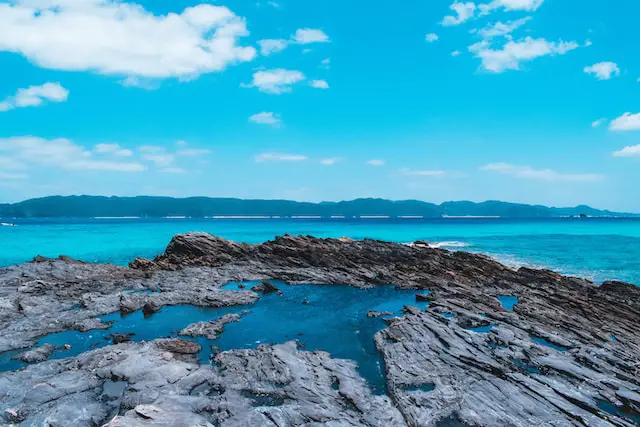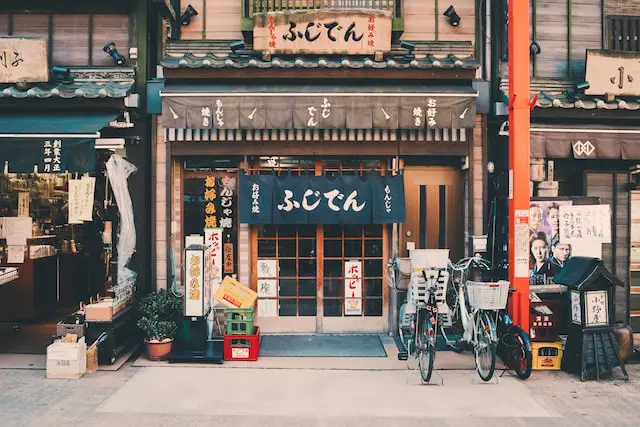Ohayou Gozaimasu, beach aficionados! Welcome to Japan, a unique travel destination blessed with hundreds of picturesque coastal areas and mesmerizing Japan beaches that will steal your heart. This stunning island nation offers a perfect blend of tranquillity, historical intrigue, and cultural richness through its expansive waterfront vistas. From the beautiful sandy stretches of Okinawa to the rocky coastal landscapes of Izu Peninsula, the diversity is as impressive as the beauty itself.
While traditional Japan travel experiences focus on bustling city landscapes and cherry blossom spotting, we invite you to explore the lesser-known, yet equally captivating seaside escapes. These coastal areas in Japan have much to offer, from sun-bathing in summer to exploring rock formations in winter, every trip promises a unique set of memories. Embrace full-circle responsible tourism, and dive deep into a different facet of Japan’s beauty—you won’t be disappointed!
Familiarize Yourself with Etiquette
A trip to the stunning Japan beaches, dipping toes into the pristine waters of coastal areas in Japan, might be your ideal fantasy. But before you embark on your exciting Japan travel, it’s essential to equip yourself with knowledge on Japanese etiquette and understand respecting local culture to ensure a fulfilling and respectful journey.
Foremost, remember that beaches aren’t just attractions; they’re communal spaces as well. It’s one of the critical Japanese beach customs to keep these spaces clean and clutter-free. Littering is highly frowned upon. Practice the mantra of ‘leave only footprints, take only pictures.’
Another integral part of Japan’s etiquette is to respect privacy and personal space. Many people in Japan use the beach as a soothing paradise to escape the daily hustle. Being too loud can interfere with their peaceful retreat. So, keep voices low and practice modesty while enjoying the beach.
Also, public display of affection is not widespread in Japan. A basic understanding and adherence to this custom can avoid any unintentional disrespect. Yes, even when you’re on a romantic gateway, less is more when it comes to public affection.
Lastly, many beaches have specific rules about swimming and beach gear. It’s always recommended to check the local guidelines before you visit.
Understanding and adopting Japanese etiquette before going to Japan’s beaches will not only enhance your cultural experience but also help in fostering mutual respect between locals and tourists. So, make sure, your responsible tourism starts with respect for their customs and etiquettes.
Leave No Trace: Promoting Environmentally Friendly Beach Visits
The concept of ‘Leave No Trace’ is an essential part of responsible tourism, serving as an important guideline for those embarking on their Japan travel adventures. When visiting the exquisite Japan beaches and coastal areas, each traveler plays a crucial role in maintaining these environmental treasures for the next generation.
Environmentally friendly travel goes beyond simply admiring the breathtaking views of the coastal areas in Japan; it requires conscious effort to ensure that our footprint is as light as possible. One way to actualize this is by carrying reusable items whenever possible. This reduces the amount of waste produced and supports the efforts made towards cleaner and safer beaches.
Additionally, sticking to designated paths while exploring these areas is vital in preserving the delicate biodiversity. It may be tempting to wander off the beaten track, but remember the vital principle of sustainable tourism—”take only memories, leave only footprints.” Respecting these guidelines helps to maintain the integrity of these unique ecosystems and habitats.
Lastly, be aware of the local guidelines regarding waste disposal, particularly when it comes to potentially harmful substances such as sunscreen. Some sunscreens can harm marine life, so opting for “reef-safe” alternatives is a responsible choice.
Through following the principles of ‘Leave No Trace’, we can play our part in preserving the pristine nature of Japan’s beautiful coastal areas. It’s not only about enjoying what Japan’s shores have to offer, but also preserving them for future generations. This way, we ensure that our Japan beach experiences remain unforgettable and sustainable for all.
Wildlife Protection and Preservation
Traveling through beautiful coastal areas in Japan offers not only a feast for the eyes but also a chance to encounter unique and diverse wildlife. Embedded in Japan’s charm is its Japanese marine life, making it another reason to fall in love with the country. Protecting this rich biodiversity is a responsibility shared by both locals and tourists. Wildlife protection, a component of responsible tourism and ecotourism in Japan, ensures the survival of these species and the health of their habitats.
As a visitor, you play a critical role in the well-being of this ecosystem. It involves respecting the animals’ natural habitats, minimizing disturbances, and ensuring you don’t unknowingly cause harm. It’s essential to keep a safe distance from wildlife, not to feed them, and not to capture them, whether for keepsakes or photographs. Sightings should be passive and respectful, treating marine life as the deserving locals that they are.
Many of Japan’s popular coastal destinations have local guides or services that educate tourists about wildlife protection. Opting for these services during your visit is a way of supporting them. These guides are often a wealth of information, teaching you about local species, their specific needs, and rules for interacting with them.
The fundamental rule, however, remains universal – leave only footprints and take only memories. It ensures that the remarkable Japanese marine life continues to thrive and future generations can enjoy the magnificent sights we are privileged to see today.
With responsible tourism becoming a crucial movement worldwide, let’s protect and preserve Japan. With every small action and choice, we can ensure that the coastlines and their inhabitants continue to prosper, enriching our global environment.
Eco-friendly Water Sports and Activities
Japan, renowned for its azure bays and sandy beaches, is a haven for a variety of eco-friendly water sports. The commitment to promoting responsible practices even in leisure activities manifests the country’s valuing of sustainable travel activities.
For the thrill-seekers, surfing is a top activity at Japan beaches, particularly in the locales of Niijima and Shikoku. It’s a sport closely tied to nature, encouraging a deep respect for the environment. Just remember to avoid causing unnecessary strain on the marine life by cleaning up after yourselves.
Sea kayaking along the Japan water activities offered enhances your appreciation of Japan’s incredibly diverse coastal regions. It’s a voyage along shallow, crystal-clear waters, and around winding coastlines, all while promoting minimal environmental impact. Yakushima and Hokkaido are favorite destinations for this tranquil pursuit.
Snorkeling, another popular activity, requires participants to follow color-marked trails, ensuring minimal disturbance to the marine ecosystem. At popular snorkeling spots like Miyakojima, you can marvel at Japan’s beautiful coral reefs and unique marine species.
Regardless of how engaging the activity may be, always remember that enjoying these remarkable coastal areas comes with the responsibility of preserving their natural beauty. Hence, undertake these activities with respect for mother nature, thereby reinforcing the ethos of sustainable and eco-friendly water sports in Japan.
Support Local Communities
One of the most authentic experiences you can have when enjoying your Japan travel adventure is fully immersing yourself in the local communities. This isn’t solely about enriching your own cultural experiences, it extends to making a difference in the lives of the locals you encounter.
Far beyond the bustling cities, coastal areas in Japan host an array of vibrant cultures, each offering unique experiences and products. By purchasing local Japanese goods, ranging from handmade craft items to local produce, you’re directly supporting these communities and helping them to thrive.
Similarly, when it comes to dining, opt for local food in Japan. By eating at local restaurants, or even snacking at the humble street food stalls, you’re not just treating your taste buds to authentic Japanese cuisine, but you’re also helping sustain these local business establishments.
Remember: supporting local Japanese communities is one of the best ways to practice responsible tourism. You’re not only fostering cultural exchange, but you’re also contributing economically to these areas, making your Japan beach adventure truly meaningful.
Understand Regulations and Safety Measures
You’re surely captivated by the allure of sparkling Japan beaches and scenic coastal areas in Japan, aren’t you? However, experiencing these breathtaking views comes with a sense of responsibility toward following local regulations and safety measures.
Japan takes safety seriously and has implemented a comprehensive set of guidelines to protect visitors and locals alike. It goes without saying that these rules also help to conserve the natural beauty of the country’s beach and coastal spots. Familiarizing oneself with these safety measures in Japan is a mark of respect towards the local culture and environment.
For instance, some beaches may have restrictions on swimming during certain times of the year due to dangerous currents or marine life. Lifeguards may be present at popular beaches, and their instructions must be obeyed at all times. Also, pay attention to signage about beach policies. This could include restrictions on beach decor, the use of certain types of beach equipment, or policies regarding waste disposal.
Remember, it is essential to understand these guidelines before planning any adventurous water activities or walks along the picturesque coastline. Ignorance may lead to heavy penalties and can, more importantly, put your life and the fragile ecosystem at risk.
The travel thrill of any Japan travel lies in respecting the local guidelines, maintaining the natural beauty of beach safety areas, and making memories while ensuring the sustainable charm of these spots is preserved for generations to come.
In conclusion, Japan travel guidelines and safety measures do not just exist for the convenience of authorities, but are put in place to ensure your security and that of the place you are visiting. You, as a visitor, hold an important role in maintaining the sanctity of these splendid coastal areas – savor it, respect it.
Conclusion
With this guide, we’ve navigated the spectacular beauty and allure of Japan’s beaches and coastal areas—the ideal destinations for both relaxation and adventure. Understanding and respecting ‘Japanese etiquette’ and ‘Japanese beach customs’ are integral for a harmonious ‘Japan travel’ experience. By paying heed to the local customs, you show your respect for Japanese culture and contribute to a more rewarding and fulfilling visit.
Furthermore, your interactions with delicate environments and diverse wildlife should align with the principles of ‘leave no trace’, ‘environmentally friendly travel’, and ‘wildlife protection’. This way, the enchanting ‘coastal areas in Japan’ can be preserved for future generations. ‘Eco-friendly water sports’ and other ‘sustainable travel activities’ offer thrilling ways to enjoy ‘Japan beach travel’ and vividly experience ‘Japanese marine life’ without negatively impacting the environment.
Remember, our role as tourists extends beyond exploration. We can support ‘local Japanese communities’, indulging in ‘local food in Japan’ and purchasing ‘local Japanese goods’. With every footprint that we place in the sand, we weave ourselves into the fabric of local communities, creating economic ripples that advance their sustenance and growth.
Finally, ensuring ‘safety measures in Japan’ and adhering to ‘Japan travel guidelines’, especially ‘beach safety’, is paramount. Understanding local regulations keeps both us and the delightful coastal destinations safe.
To sum up, ‘Japan beach travel’ offers an intriguing blend of cultural, natural, and adventurous experiences. However, the key to unlocking this beautiful realm lies in ‘responsible tourism’ and ‘sustainable Japan travels’. With mindfulness, respect, and responsibility, each one of us can contribute to the protection and preservation of these captivating ‘Japan beaches’, ensuring they remain unforgettable slices of paradise for years to come.




